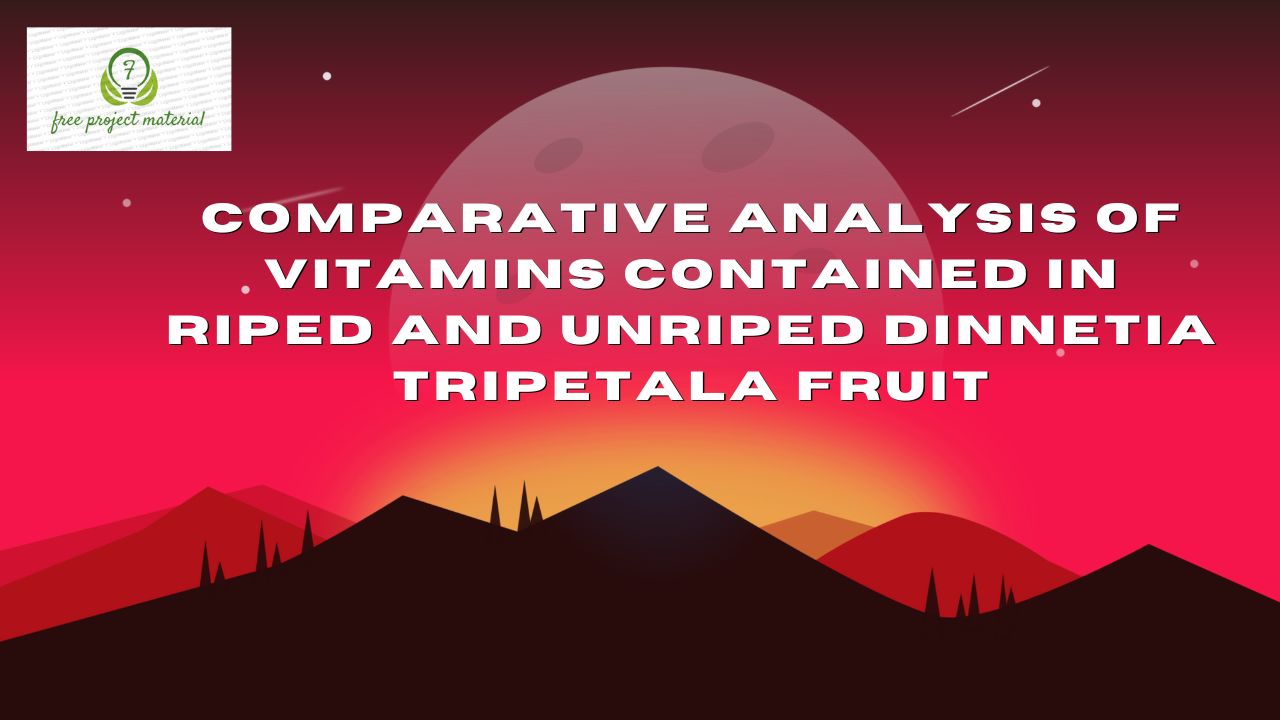ABSTRACT
The research work was on comparative analysis of vitamins contained in ripe and unripe Dinnetia tripetala fruit. The vitamins A and B was estimated spectrophotochemically. The analysis of vitamins A in ripe and unripe Dinnetia tripetala was 6.59±0.09 and 7.26±0.05. The vitamin B1 contained in ripe Dinnettia tripetala was 1.26±0.02 and unripe was 3.09±0.01. vitamin B2 contained in ripe and unripe Dinnetia tripetala was 3.22±0.3 and 4.06±0.04. vitamin B3 contained in ripe and unripe Dinnetia tripetala was 0.17±0.2 and 2.07±0.32. the vitamin C contained 0.28±0.03 for ripe and 3.06±0.42 for unripe Dinnetia tripetala respectively. The result of the analysis showed high vitamins content in unripe Dinnetia tripetala.
TABLE OF CONTENTS
Title Page – – – – – – – – – i
Certification – – – – – – – – ii
Dedication – – – – – – – – – iii
Acknowledgments – – – – – – – – iv
Abstract – – – – – – – – – v
Table of Contents – – – – – – – – vi-viii
CHAPTER ONE: INTRODUCTION
1.1 Background of the Study – – – – – – 1-3
1.2 Aim and Objectives of the Study – – – – 3-4
1.3 Scope and Limitation of the Study – – – – 4
1.4 Significance of the Study – – – – – – 4-5
1.5 Definition of Terms – – – – – – 5
CHAPTER TWO: LITERATURE REVIEW
2.1 Botanical Classification of Dennettia tripetala – – 6
2.2 Description and Geographical Distribution of
Dennettia tripetala – – – – – – – 6-7
2.3 Phytochemistry and Nutritional Value of
Dennettia tripetala – – – – – – – 7-9
2.4 Health Benefits of Dennettia tripetala – – – – 9
2.4.1 Antimicrobial Properties of Dennettia tripetala – – 9-10
2.4.2 Analgesic and Anti-Inflammatory Effects
of Dennettia tripetala – – – – – – 10
2.4.3 Antihyperglycemic Effect of Dennettia tripetala – – 10-11
2.4.4 Antioxidant Effect of Dennettia tripetala – – – 11-13
2.5 Toxicity of Dennettia tripetala – – – – – 13-15
2.6 Vitamins – – – – – – – – 15-17
2.6.1 Sources – – – – – – – – 17-18
2.6.2 Deficient Intake – – – – – – – 18-20
2.6.3 Excess intake – – – – – – – 20-21
2.6.4 Recommended levels – – – – – – 21-24
CHAPTER THREE: MATERIALS AND METHOD
3.1 Sample Collection and Preparation – – – – 25
3.2 Identification of Sample – – – – – – 25
3.3 Sample Treatment – – – – – – – 25
3.4 Determination of Vitamins – – – – – – 26-27
CHAPTER FOUR: RESULTS AND DISCUSSION
4.1 Result s – – – – – – – – 28
4.2 Discussion – – – – – – – – 29
CHAPTER FIVE: CONCLUSION AND RECOMMENDATIONS
5.1 Conclusion – – – – – – – – 30
5.2 Recommendations – – – – – – – 30
References
CHAPTER ONE: INTRODUCTION
1.1 Background of the Study
Dennettia tripetala (pepper fruit) is an indigenous fruit tree of the family Annonaceae. It’s widely distributed and consumed by the inhabitants of Western Cameroons, Ivory Coast and Southern Nigeria. It is a medium- sized or small tree which spreads throughout the rain forest and sometimes found in forest within the Savanna areas (Etukudo, 2000).
Dennettia tripetala fruits appear red when ripe and green when unripe. The matured fruits constitute the main edible portion. The leaves, fruit, bark and root of the plants possess strong pepperish and pungent spicy taste with a characteristic aroma and fragrance. The young leaves and fruits have instinctive spicy taste (Achinewhu et al., 1995). The fruits are chewed in different forms (fresh green, fresh ripened red, black dry fruit and dry seed).
Dennettia tripetala fruit serve as mild stimulant to the consumer. The fruits and leaves are used as seasonings which are added to prepared food such as meat, soup, sausage and in some special local dishes and vegetables (Ejechi and Akpomedaye, 2005). Dennettia plant yields a good fuel wood (Abbiw, 1990). Its various parts are commonly used as spices and condiment (Oyemitan, 2008). The fruit is sold for money especially by rural women.
Dennettia tripetala fruits have been reported to contain important nutritive substances such as vitamins, minerals and fiber (Okwu et al., 2005). It was also indicated that the rich presence of essential oil (oleoresins) determines the aromatic flavoring, coloring and pungent properties of pepper fruits. Nwaogu et al. (2007) investigated phytochemical content of Dennettia tripetala and detected the presence of saponins, flavonoids, tannins and cyanogenic glycosides.
Also, Adedayo et al., (2006) reported the presence of flavonoids in Dennettia tripetala. The intake of flavonoids in any fruit and vegetable tends to decrease cancer risk (Graf et al., 2005). Flavonoid contributes to the color of plants, their fruits and flowers. Timothy and Okeke (2005) reported that ingestion of 0.75g of Dennettia tripetala reduces the intraocular pressure (IOP) of normotensive emmetrops though not sustained at 30 minutes post consumption.
The IOP was reduced by 17.30% (12.90 mmHg) from the mean baseline of 15.60 mmHg (Graf et al., 2005).
Vitamins have diverse biochemical functions. Vitamin A acts as a regulator of cell and tissue growth and differentiation. Vitamin D provides a hormone-like function, regulating mineral metabolism for bones and other organs. The B complex vitamins function as enzyme cofactors (coenzymes) or the precursors for them. Vitamins C and E function as antioxidants. Both deficient and excess intake of a vitamin can potentially cause clinically significant illness, although excess intake of water-soluble vitamins is less likely to do so. Thus, this study is aimed at determining the vitamins content of both riped and unriped Dinnetttia tripetala fruit (Bender, 2003)
1.2 Aim and Objectives of the Study
The aim of this study is to determined the comparative vitamins contents of riped and unriped Dinnettia tripetala fruit.
The specific objectives of this study are;
- To determine the vitamins contents in riped Dinnettia tripetala fruit.
- To determine the vitamins contents in unriped Dinnettia tripetala fruit
- To compare the two result and with previous studies
- To make useful recommendations base on the result of this study.
1.3 Scope and Limitation of the Study
This study only focus on the comparative analysis of vitamins in riped and unriped Dinnettia tripetala . Due to time and financial constraint this study is limited to only the vitamins contents of the fruits only.
1.4 Significance of the study
This study will serve as source of information to people and individual on the vitamins contents of Dinnettia tripetala so has to enhance or facilitate their utilization.
The study will also serve as a source of information to nutritionist and health officials as it will form the bases for nutritional recommendations.
This work will also serve as a reference materials to students and future researchers in this field of study.
1.5 Definition of Terms
Dennettia tripetala: Dennettia tripetala, referred to as DT, is also known as pepperfruit. It is widely grown in the rain forest zones of Nigeria and some parts of West Africa. DT is commonly consumed for its spicy taste.
Vitamins: A vitamin is an organic molecule (or a set of molecules closely related chemically, i.e. vitamers) that is an essential micronutrient that an organism needs in small quantities for the proper functioning of its metabolism.


